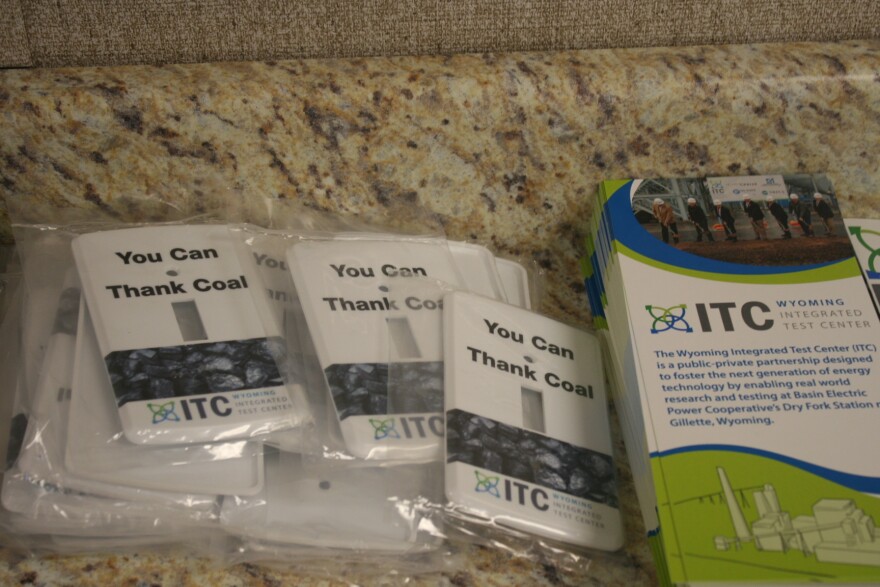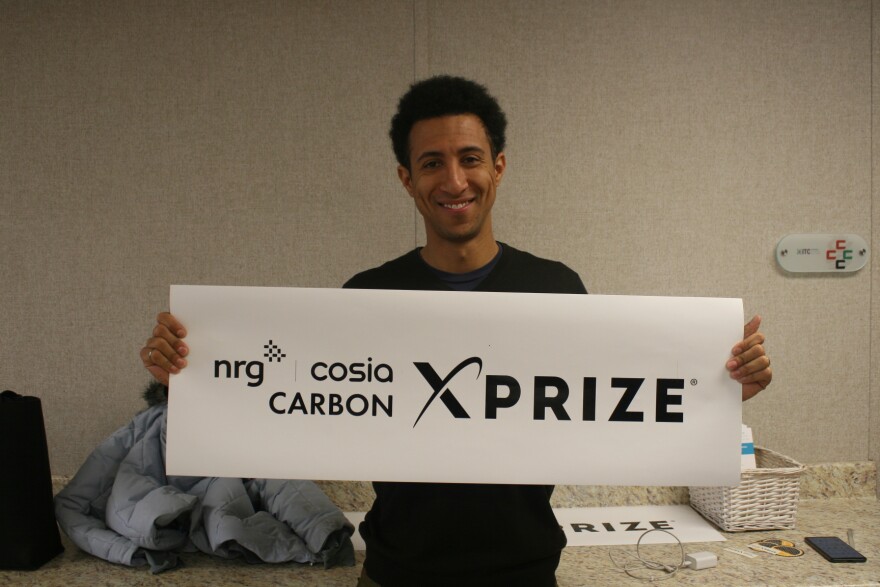Hundreds of train cars overflowing with coal extend alongside a road. Trucks haul the same energy resource in a large pit on the other side of the road. The highway is outside of Gillette, Wyoming, commonly called the coal capital of the U.S.
"Nobody is here in this part of the world. It is so empty. So empty," laughs Sebastian Peter who traveled to be here from Bangalore, India. His team, called Breathe is one of the finalists in the NRG COSIA Carbon XPRIZE competition.

Four of the five finalist teams, including Peter, huddle together on an empty gravel lot next to the massive Dry Fork Station coal-fired power plant. A pipe reaches across the front of the lot.
"This is it… this is where they take the flue gas," says Ray DeStefano, operations manager at Dry Fork.
The site will soon be full of mini industrial plants used to transform carbon dioxide into valuable commercial products. Jason Salfi is the CEO of Dimensional Energy and another finalist competing for $7.5 million in prize money. He scopes out where to set up shop.
"We'd be best probably over in there… we're looking for the maximum solar resource," Salfi says.
He wants to combine solar energy with carbon dioxide, "and out the other side we'll be producing high purity carbon monoxide."
That could be used for greener fuel alternatives. Other finalists are using CO2 to create cement, plastics and adhesives. During the competition, each team will work to scale up their technology and demonstrate its potential.
"This isn't a regular everyday engineering project," says Marcius Extavour, who runs the Carbon XPRIZE competition. He says it's about changing the narrative around carbon dioxide.
"We know carbon dioxide, it's causing a big problem. It's driving climate change and if we don't do something about it we're in for a more and more serious future," Extavour says.

Moving our energy sources from fossil fuels to renewables is the most common go-to in mitigating climate change, but major agencies say more is needed. The Intergovernmental Panel on Climate Change reports keeping global temperatures within a livable range would be too expensive without carbon capture. The International Energy Agency also says carbon capture is a necessary step. But to get there the technology needs to develop a lot faster than it is now. One scenario requires carbon capture annual rates to improve by over 7000 percent by 2040. Extavour has faith this competition will help move the industry forward.
"There is enough time, but we have to get cracking in a serious, serious way," he says.
The federal government seems to agree. The U.S. Department of Energy has already invested billions of dollars in the technology including funding for several demonstration projects. Last year, Congress adopted a tax-credit to stimulate carbon capture projects; it's expected to trigger a billion dollars of new investment in six years. Wyoming wants in too. Governor Mark Gordon says the state is ready to be America's "carbon valley."
"No one has done the work that we have in the policy framework… so, we're really poised to be the nation's leader in this technology," Gordon says.
For example, the Carbon XPRIZE competition is being hosted by the private and state-funded Integrated Test Center. Gordon says a thriving carbon capture industry doesn't just help emissions, it prolongs coal's life. Wyoming provides 40 percent of the country's coal and it's a top five revenue source for the state.
"It seems incredibly important at this stage that we are invested in trying to revitalize coal assets that we have, give them new life, give them new purpose," Gordon says.
But time is running out -- coal has become increasingly uneconomic, and coal plants are shutting down across the country. Plus, adding carbon capture to the average coal plant would triple the cost of electricity.

Dennis Wamsted, an editor with the Institute for Energy Economics and Financial Analysis, says, "it's a very expensive technology and very little evidence the expense of the technology can be cut significantly, especially given the competition."
Right now, carbon capture sequesters only 0.1 percent of total global emissions. The timeline to improve that number is short. Coal consumption is already historically low, with the Energy Information Administration predicting another decline of 23 percent by 2050.
"In my opinion, perhaps the race is already over," Wamsted says.
XPRIZE's Extavour does not agree.
"The race is on, and it's a pressure cooker now."







